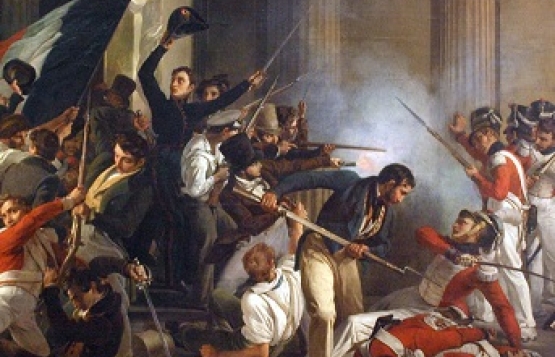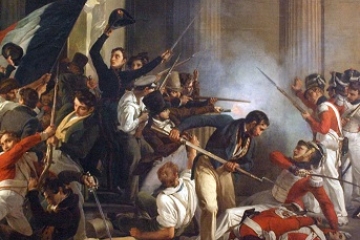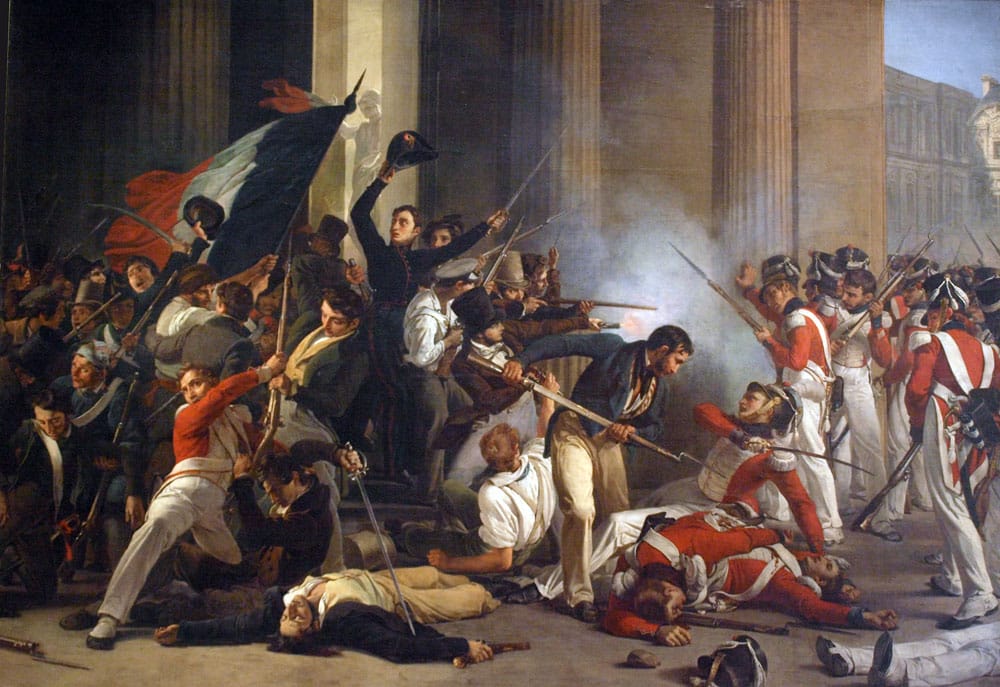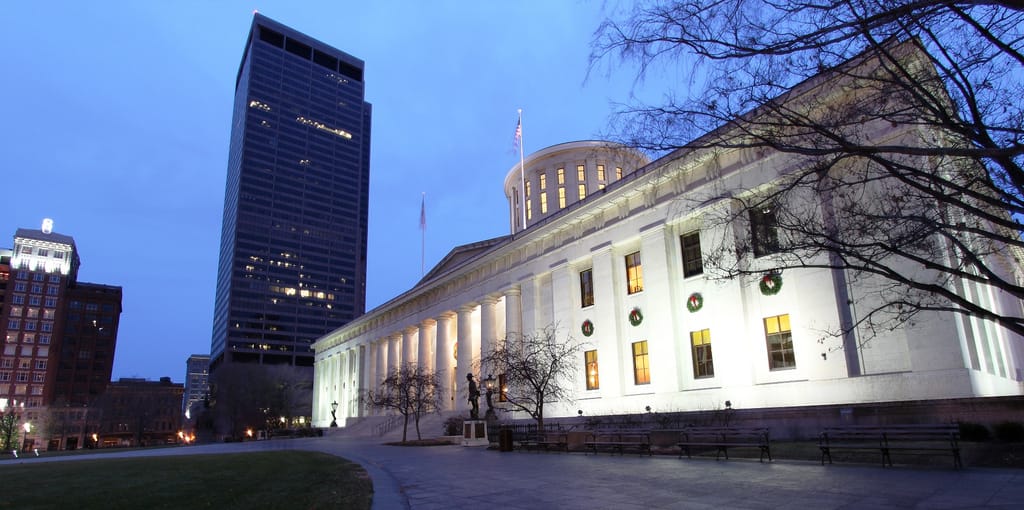
What the Dickens! 2014 in Education Reform
It was the best of times, it was the worst of times. Michelle Lerner, Robert Pondiscio, and Alyssa Schwenk

It was the best of times, it was the worst of times. Michelle Lerner, Robert Pondiscio, and Alyssa Schwenk








It was the best of times…
…for the Republican Party. Election Day 2014 was a rout, with the GOP winning full control of Congress and its largest House majority since World War II. Republican governors were re-elected in Florida, Wisconsin, Michigan, Kansas, and Maine. Democrat Pat Quinn was booted out of office in President Obama’s home state of Illinois. Republican now control two-thirds of state legislatures too. The GOP groundswell “will be good for education reform, especially reforms of the school-choice variety,” predicted Fordham’s Mike Petrilli.
It was the worst of times…
...for teachers’ unions. “It’s open season on teacher employment protection laws in U.S. state courts,” noted Fordham’s Brandon Wright on the heels of June’s Vergara v. California verdict holding California’s tenure laws unconstitutional. And the hits just kept on coming. In October, the commission that runs the financially troubled Philadelphia public school system unilaterally canceled the union’s contract and ruled teachers must contribute to their health insurance to free up money for classrooms. (A good decision to avoid the big squeeze.) Election Day made the annus horribilis complete. The $60 million the AFT and NEA spent on campaigns merely advertised their impotence. The unions took out their frustrations in the waning days of 2014 on a TIME magazine cover story on tenure. “It’s a lot easier to gin up phony outrage over magazine covers than reckon with the question of why voters are no longer buying what you’re selling,” retorted Fordham’s Michael Brickman.
It was the age of wisdom….
Despite defeats in a handful of states, Common Core remains intact throughout most of the nation. “The Common Core standards aren’t perfect, but they’re pretty darn good,” Petrilli argued at NPR’s Intelligence Squared debate in New York City in September. “Perhaps most importantly, after four years of hard work from our educators nationwide, they have momentum. They are raising expectations in our schools and raising the quality of teaching and learning.” Anti-Common Core rhetoric seemed to subside in the weeks following the mid-year election. But the standards’ stiffest challenge may come next year when Common Core-aligned testing begins in earnest. Millions who believe American education is second-rate while their own children’s schools are performing well may have that article of faith tested.
It was the age of foolishness…
…for New York Mayor Bill de Blasio. Overly enamored of his own Tale of Two Cities campaign rhetoric and presuming a populist mandate, he went to war with Eva Moskowitz, cancelling plans for three of her Success Academy charter schools. Pro-school-choice parents led by Moskowitz descended on Albany, winning both the support of Democratic New York Governor Andrew Cuomo and a state budget deal requiring the city to provide charter schools with public school space or funding for private rent. “There's no way in hell Eva Moskowitz should get free rent,” de Blasio had fumed during last year’s campaign. Only the New York Jets have suffered more humiliating defeats in Gotham this year. Mayor de Blasio has meanwhile turned his attention to ridding the city’s street of horse-drawn carriages.
It was the epoch of belief…
…for Fordham’s Chester E. Finn, Jr., who handed the reins to longtime Gadfly Michael J. Petrilli. In bidding farewell, Finn noted that education reform has come a long way: “We now judge schools by their results, not their inputs, intentions, or programs. The results we focus on deal, for the most part, with pupil achievement. And while we continue to struggle with the details, over the years we’ve developed academic standards that set forth the results we seek, we’ve created assessments and other measures to gauge how well they’re being achieved.” But there is urgent work ahead, notes Fordham President Petrilli, including an “incoherence problem” of various reforms working against one another—most notably the contradictory efforts to expand school-level autonomy while micromanaging teacher-evaluation processes from on high.
It was the epoch of incredulity…
…in Louisiana, where you’d be hard-pressed to find anyone who believes that Bobby Jindal’s reversal on Common Core is anything other than political opportunism. Every news article about his flip-flop mentioned the Louisiana governor is a 2016 presidential aspirant—all the explanation anyone seemed to need. And while he did not win TIME’s Person of the Year, he is Fordham’s 2014 Common Core Man of the Year for suing the federal government over the standards, thereby throwing “into profound jeopardy the most effective talking point that their opponents have: that the feds forced national standards down the states’ throats and that Uncle Sam is illegally dictating what schools will teach,” noted Fordham’s Robert Pondiscio, who argued the suit has virtually no chance of success.
It was the season of Light…
…for Eva Moskowitz. The founder of New York City’s Success Academy established herself as ed-reform’s unquestioned “It Girl” in 2014 by handing new mayor Bill de Blasio an embarrassing political defeat when attempted to block further expansion of her charter network. And those test results! Success Academy kids aced the state’s tough new Common Core-aligned tests—beating out most other New York City schools, public and charter alike. “This is Secretariat winning the Belmont by thirty-one lengths,” wrote Fordham’s Robert Pondiscio in the New York Daily News. “It’s Michael Jordan dropping sixty-three points on the Celtics in the playoffs. It’s Tiger Woods demolishing the field and winning the Masters by eighteen strokes.”
It was the season of Darkness…
…at the nation’s education schools, which continue to frustrate and disappoint. With books like Elizabeth Green’s Building a Better Teacher dominating the bestseller lists, and Common Core implementation dominating the conversation, ed schools continued to come under scrutiny in 2014. NCTQ published the second edition of their teacher prep review. But education schools remain an intractable policy problem: Just this week, Education Week reported that states or universities have shuttered or suspended fewer than sixty teacher preparation programs—out of 25,000—for poor performance over the last twenty-five years.
It was the spring of hope…
…for ESEA reauthorization. After Republicans took control of the Senate in the November midterms, chances of a new NCLB passing both houses of Congress increased significantly. And Secretary of Education Arne Duncan and President Obama have indicated they’re ready to play ball. Have we had our hopes up on this topic before? Yes. But now, there’s some substance to what we’re hoping for.
It was the winter of despair…
…for those concerned with real federal overreach. No, not Common Core, but the Office of Civil Rights and its six years of meddling: from the war on school discipline to a supposed “right” to take Advanced Placement courses. In 2015, the OCR might investigate a school because its rogue administrator approved “painting classrooms with Sherwin-Williams’s Toasted Pine Nut instead of Benjamin Moore’s Tuscany,” noted Joshua Dunn.
We had everything before us…
…including detailed data on how much schools are spending in the D.C. metropolitan area. Shedding light into the murky world of school finance, some encouraging findings emerged: Namely, most of the D.C.-area districts are spending significantly more on their poorest schools, for which they deserve credit. Unfortunately, the Washington area’s poorest district—Prince George’s County, Maryland—is the exception, thanks to its shaky property-tax base. You can’t redistribute what you don’t have.
We had nothing before us…
Well, it was right in front of our noses, but we just didn’t see the non-teachers that make up 50 percent of school staff. “[C]ontemporary education leaders should look carefully under this hood: school employees are the primary engines of student learning and they’re also by far the largest category in district budgets.”
We were all going direct to Heaven…
And lest we forget to be humble, recall that 2014 was the year, as decreed by No Child Left Behind, that every state would achieve universal proficiency. The grand work of ed reform complete, this was to be the last Education Gadfly ever produced, as we honored the Cincinnatean ideal, quit the capital and statehouses, and returned to our fields...
We were all going direct the other way.
…see you in 2015.
photo credit: Ard Hesselink via Flickr


This fall, the editorial boards of two of Ohio’s most widely read newspapers issued stinging missives urging legislators to make sweeping changes to the state’s charter school law. In September, the Plain Dealer opined that lawmakers should “work together on a bill to improve charter schools.” One month later, in light of revelations about a questionable charter-facilities deal, the Columbus Dispatch argued that charter reform “should address questionable lease deals along with other loopholes, conflicts and oversights in Ohio’s charter-school system.”
They’re absolutely right: 120,000 Buckeye charter students deserve to attend a school governed by a great charter law—a law that puts the interests of children first. But at the present time, Ohio’s charter law too often fails to protect these students’ best interests; instead, in too many ways, it protects powerful vested interests, smothers schools with red tape, starves even the best schools, and tolerates academic mediocrity.
Predictably, overall charter school performance in Ohio has been lackluster. In the two most extensive evaluations of Ohio charter performance in 2009 and 2014, Stanford University’s Center for Research on Education Outcomes (CREDO) found that Ohio charter school students, on average, make less academic progress than their district counterparts. The 2014 results, released last week, estimated that charter students received an equivalent of fourteen fewer days of learning in reading and forty-three fewer days of learning in math.
But fixing Ohio’s charter law is no easy task. The law itself is roughly 40,000 words and has been amended nineteen times since its enactment in 1997. It contains many peculiar exceptions, loopholes, and restrictions. Few would argue that the current law clearly expresses how the charter school system ought to function.
Policymakers must know exactly what needs to be repaired and how best to make the fix. To assist in this task, Fordham enlisted Bellwether Education Partners, one of the smartest education-consulting firms in the land. Their analyst (and Fordham fellow) Andy Smarick, who has worked on charter policy issues with the New Jersey Department of Education and the United States Department of Education, agreed to conduct a thorough review and analysis of Ohio charter law (along with two Bellwether colleagues). Their report, released on Monday, offers ten policy recommendations that, if implemented, will lead to stronger charter policy in Ohio. In our view, these recommendations pivot around three central objectives that policymakers must focus on in a charter-reform bill.
First, the state must better define governing relationships. Currently, Ohio charter law too vaguely delineates the powers and responsibilities of each actor in the charter-governing system. State policymakers need to remedy this by more clearly and explicitly establishing the governing relationships, starting with the powers and duties of the state board and the Ohio Department of Education. From there, policymakers must make clear the responsibilities of charter school authorizers, governing boards, and management companies—and to whom (and how) each entity is held accountable.
State policymakers must also work to purge conflicts of interest. Authorities should not tolerate permissive laws that allow adults to make dishonest gain at the expense of students’ best interests. For example, a charter authorizer—the entity that regulates a charter school—is allowed to sell services to its schools. This bizarre arrangement creates an obvious disincentive for an authorizer to hold its school accountable, especially if closure becomes necessary. Ohio charter school law also strongly protects management companies, even if they fail to deliver a quality education. Because of a loophole in law, charter school boards have little leverage to terminate a management contract. One national policy analyst gave this particular provision “the award for the most breathtaking abuse in the nation.”
Finally, charter schools need help to compete. At present, state policy treats Ohio charters as second-class public schools. They receive less overall taxpayer funding, garner scant facilities support, and are often at the mercy of traditional districts when it comes to student transportation. Taken together, state policy places charters on an uneven playing field with their district counterparts. While a few Ohio charters are producing exemplary results through smarts and raw determination, their outcomes are the exception rather than the rule. For too long, policymakers have unfairly asked charters to make educational bricks without straw, and now is the time to remedy charter-funding inequities.
In 2006 Fordham, along with two national charter organizations, published seventeen recommendations for Ohio charter-policy reform in a report titled Turning the Corner to Quality: Policy Guidelines for Strengthening Ohio’s Charter Schools. Some of its suggestions have been adopted, including fairer school accountability that includes student-growth measures and a rigorous evaluation system for charter school authorizers. Yet other recommendations have fallen on deaf ears.
Eight years later, the Ohio policy community is poised yet again to tackle charter school reform. Fordham’s latest report, The Road to Redemption: Ten Policy Recommendations to Improve Ohio’s Charter Sector, builds on the policy foundations laid in 2006, considers the latest developments in Ohio charter policy, and reflects some of the very best thinking nationally concerning charter school policy. Wise policymakers—those who care deeply about the twin principles of good governance and robust competition in our public institutions—will carefully consider its lessons in the coming days.


SOURCE: Soohyung Lee, Lesley J. Turner, Seokjin Woo, and Kyunghee Kim, “All or Nothing? The Impact of School and Classroom Gender Composition on Effort and Academic Achievement,” National Bureau of Economic Research, Working Paper No. 20722 (December 2014).

The charter school sector in the United States encompasses forty-two states and the District of Columbia, with 6,400 charter schools serving 2.5 million students. More than 1,000 authorizers oversee these schools, working under state laws that seek to balance school autonomy and accountability for results. This report, conducted by the National Association of Charter School Authorizers (NACSA), evaluates the quality of those laws. NACSA has identified eight policies that facilitate the development of effective charters, including performance management and replication, default closures, and authorizer sanctions. States are awarded points—on a thirty- or twenty-seven-point scale, depending on the group—based on the strength each of these policies in their charter schools laws. NACSA divided the states into three groups, according to their charter-authorizing landscapes, and then assigned ranks within. They include: (1) seventeen district-authorizing states, (2) five states with many authorizers, and (3) twenty-one states with few authorizers. South Carolina topped the first list with a score of twenty-five out of thirty. Last place here (and in the nation) is Kansas, with zero, for which the report blamed the state’s “dead” charter law; though legal, the schools do not have autonomous governing boards or alternative authorizers. In the second group, Indiana led with eighteen points out of a possible twenty-seven. And despite being the newest charter state, Washington earned not only the best marks in the final group, but the best in the nation—a perfect thirty out of thirty. Speaking of perfection, NACSA unfortunately does not achieve it; a few of its grades are more than a little baffling. New York and the District of Columbia, in particular, get surprisingly low marks even though their authorizers are legendary for their commitment to quality. But on the whole, it’s a worthy effort. Be sure to check out the report.
SOURCE: “On The Road to Better Accountability: An Analysis of State Charter School Policies,” National Association of Charter School Authorizers (December 2014).

With the fiftieth anniversary at hand for the celebrated and once-controversial "Moynihan Report," the late Senator Daniel Patrick Moynihan is back on people's minds and keyboards. There will be more of this attention as 2015 unfolds. But Pat Moynihan is seldom off my mind, as he was primus-inter-pares of the mentors who mattered in my life and career, as well as my primary boss in three different settings between 1969 and 1981 (not to mention my doctoral advisor). My first "grown-up" job at his side—if age twenty-five counts as grown-up—was as a junior White House education aide at the start of the Nixon administration. (My version of this tale is recounted in the early chapters of Troublemaker, if you're a real glutton for punishment.) Pat was an assistant to the president for urban affairs, with an office in the West Wing not far from Kissinger's. The other room in his cramped basement suite was occupied by his chief deputy, Steve Hess (who for most of the time since has been an exceptionally prolific senior fellow at Brookings and one of Washington's true "wise men"—as well as a member of the vanishing species known as "moderate Republicans”). Steve has now written, and Brookings has just published, a thoroughly delightful account of the eventful first year of the Nixon-Moynihan relationship, which was unlikely from the outset, but rapidly proved to be both mutually beneficial and highly productive. The Professor and the President is short, utterly readable and already the subject of positive reviews. It's not mostly about education, but it's about two of the most interesting and remarkable individuals in American government during the latter half of the twentieth century, as observed through the eyes of a third. You will close it wondering why they're not making this model very often nowadays—and, perhaps, even more firmly resolved to persevere in this fracas yourself.
SOURCE: Stephen Hess, The Professor and the President: Daniel Patrick Moynihan in the Nixon White House, (Washington, D.C.: Brookings Institution Press, 2014).

This study in the Educational Evaluation and Policy Analysis Journal examines the role of the school environment in relation to teacher effectiveness over time. On average, we know that teachers tend to make rapid gains in effectiveness in their early years—and that this growth rate tapers off with additional experience. But this finding is too broad. Thus, analysts explored the differences that exist across individual teachers working in different schools to uncover the role that school culture might play in their varied effectiveness over time. They use administrative records from third to eighth grade for years 2000–2010 in the Charlotte-Mecklenburg schools, which include more than 280,000 student records and roughly 3,200 teachers. They combine these data with responses from a state teacher survey that gauges working conditions, such as whether the school is safe, orderly, and characterized by mutual trust and respect; whether teachers collaborate on teaching practices; whether the principal supports teachers; and so on. After controlling for numerous student-, peer-, school-, and teacher-level variables, analysts find that the variation in returns to teaching experience is explained in part by differences in schools’ professional environments. Findings show that working in a more supportive environment is related to improvement that actually accumulates throughout the first ten years of a teacher’s career. (The gift that keeps on giving!) Specifically, after ten years, teachers working at a school with a more supportive environment moved up in the distribution of overall teacher effectiveness by roughly one-fifth of a standard deviation more than teachers who work in less supportive environments. The bottom line: Paying attention to what schools can do to create more supportive teaching and learning environments may be just as important as recruiting the right people to work in them.
SOURCE: Matthew A. Kraft and John P. Papay, “Can Professional Environments in Schools Promote Teacher Development? Explaining Heterogeneity in Returns to Teaching Experience,” Educational Evaluation and Policy Analysis, Vol. 36, No. 4 (December 2014).